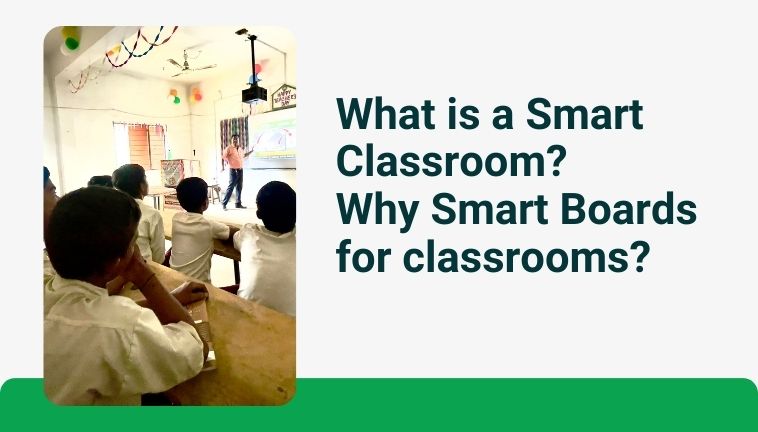Blogs
What is Smart Classrooms? Advantages, Importance, & Major Components

Ever encountered the term smart classrooms or had the chance to teach in one? The concepts of smart classes and smart boards are not new in the educational sphere. Yet, the question remains: what defines a smart classroom?
According to MarketResearch.com, the global market for EdTech and smart classrooms is projected to hit a staggering USD 333.327 billion by 2027. As detailed in the ‘EdTech & Smart Classroom Market Intelligence Report Global Forecast to 2027’. In a similar vein, the Smart Classrooms Market in India is on an upward trajectory, anticipated to expand at a CAGR of 4.05%. And reach an impressive USD 16.11 billion by 2026.
In this blog, we’ll start by unpacking the concept of a Smart Class along with other emerging technology. Stick around, as we’ll delve into the various types of Smart Classes available now. And explore the exciting innovations on the horizon.
What is Smart Classrooms?
Smart Classrooms is an advanced digital learning environment that enhances traditional teaching methods with modern technology. By integrating various digital tools and innovative technologies, smart classrooms aim to improve teaching efficiency and create an engaging, dynamic environment for students. They prioritize a healthy, stimulating environment where students are motivated and eager to learn.
This approach boosts engagement and fosters high-achieving students. Especially in an online environment where focus is fleeting, smart class technology proves invaluable in captivating student attention.
Smart classrooms represent a transformative shift in the educational landscape, combining traditional teaching methods with advanced technology to create an interactive and engaging learning environment. Here’s a brief look at their importance and the advantages they offer.
Importance of Smart Classrooms
Enhanced Engagement: Smart classrooms captivate students' attention with interactive content, multimedia presentations, and real-time feedback, making learning more dynamic and enjoyable.
Personalized Learning: With the help of technology, educators can tailor lessons to meet individual students' needs, ensuring that each student can learn at their own pace and style.
Improved Access to Resources: Smart classrooms provide easy access to a vast array of digital resources, including e-books, online courses, and educational videos, broadening the scope of learning materials available to students.
Advantages of Smart Classrooms
Interactive Learning: Tools such as interactive whiteboards and educational apps foster a more hands-on learning experience, encouraging student participation and collaboration.
Enhanced Teaching Tools: Teachers have access to a variety of digital tools that can make their instruction more effective and efficient, such as automated grading systems and lesson planning software.
Real-Time Assessment: Instant feedback from quizzes and interactive activities allows teachers to quickly identify and address students' learning gaps.
Accessibility and Inclusivity: Smart classrooms can accommodate diverse learning needs, offering assistive technologies for students with disabilities and language support for non-native speakers.
Future-Ready Skills: By integrating technology into everyday learning, smart classrooms prepare students for a tech-savvy world, equipping them with essential digital skills for future careers.
What are the Major Components of Smart Classrooms?
Smart classroom tools are designed to enhance the learning experience by integrating technology with traditional teaching methods. Here are some practical examples:
Interactive Whiteboards: These have become a staple in modern classrooms, allowing teachers to project content and interact with it directly on the board. Leveraging Schoonet’s Geneo Interactive Flat Display Panels, teachers can create lively and interactive lessons.
Smart Projection Systems: These systems can transform any surface into an interactive one, making lessons more dynamic.
Coupled with Geneo Interactive Flat Display Panels, Smart class solutions such as KYAN, can jot down notes or type on the display, draw attention to key points using highlights, circles, arrows, or zoom, and effortlessly integrate multimedia elements like videos, websites, slideshows, and pictures.
High-definition Document Cameras: They display detailed images of documents, diagrams, and physical objects to the entire class.
Learning Management Systems (LMS): LMS platforms help organize course content, assignments, and feedback in one place.
Tablets and eBooks: These portable devices provide access to a vast array of educational resources and interactive textbooks.
These tools are transforming classrooms into interactive, engaging environments that cater to various learning styles and needs. But in this blog, we'll be focusing on Smart Boards and discover how they can help transform traditional classrooms into future classrooms.

What are Smart Boards?
Smart Boards stand out as transformative innovations in education. Far from being mere high-tech substitutes for traditional chalkboards. They serve as practical instruments that deliver a host of advantages for educators and learners alike.
A 2022 Gallup study revealed that digital tools are crucial in enhancing student performance. They simplify at-home learning and raise the bar for educational advancement.
Smart boards, also known as interactive whiteboards or electronic whiteboards, are expansive displays that can be mounted on walls or placed on mobile stands. These devices enable interaction, collaboration, and data manipulation with just a touch or a mouse click.
Why Smart Boards are important for Smart Classrooms?
Serving as an engaging platform for both educators and learners, smart boards allow for on-screen editing and note-taking using a stylus or a fingertip. They also support seamless communication and interaction with various gadgets, including smartphones, tablets, Chromebooks, and computers within smart classrooms.
Smart boards offer a multitude of benefits for both teachers and students, transforming the classroom into an interactive and engaging learning environment.
For Teachers
Interactive Teaching: Smart boards make lessons more dynamic, allowing teachers to incorporate multimedia elements like videos and animations.
Customized Instruction: They enable personalized teaching, catering to the diverse learning needs of students.
Resource Accessibility: Teachers have instant access to a wide range of online resources to reinforce their lessons.
Efficiency: Smart boards are low maintenance and easy to use, increasing teacher productivity.
For Students
Engagement: The interactive nature of smart boards keeps students engaged and motivated.
Collaborative Learning: Students can work together on projects and share ideas, fostering teamwork.
Visual Learning: They cater to visual learners by displaying diagrams, charts, and videos on a large screen.
Digital Literacy: Familiarity with smart boards prepares students for a technology-driven future.
In Conclusion
Smart classrooms are revolutionizing education by making learning more engaging, personalized, and accessible. They offer numerous benefits for both students and teachers, fostering an environment where technology enhances the educational experience and prepares students for the future.
Smart boards are supported by an array of intelligent resources, including digital textbooks, interactive simulations, and content-rich multimedia. These tools adapt to different learning preferences, enabling teachers to tailor their methods to each student’s unique requirements and create a 360-degree Smart Classrooms experience.
Smart classroom technology is a true asset to education. It elevates student self-assurance and inspires expansive thinking. Schoolnet embraced this technology early on, recognizing that today’s students shape the future. Investing in their potential paves the way for a brighter tomorrow.




